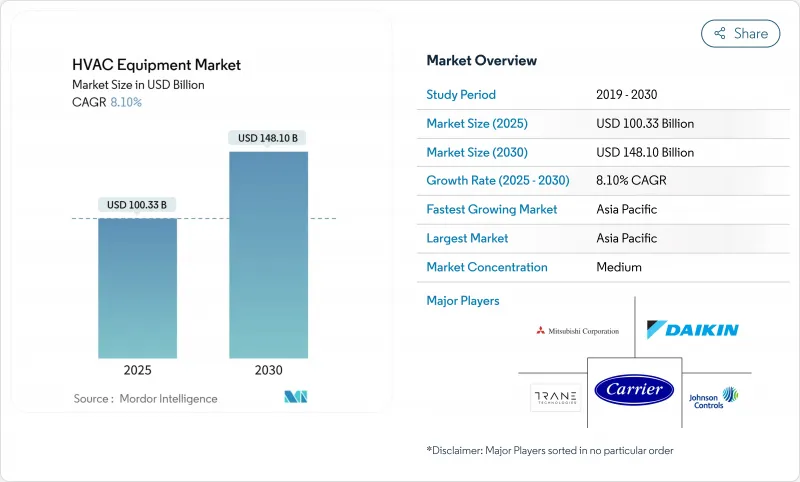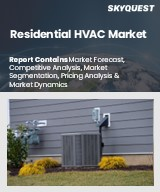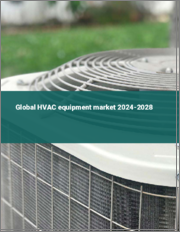
|
시장보고서
상품코드
1844484
HVAC 장비 시장 : 점유율 분석, 산업 동향, 통계, 성장 예측(2025-2030년)HVAC Equipment - Market Share Analysis, Industry Trends & Statistics, Growth Forecasts (2025 - 2030) |
||||||
HVAC 장비 시장의 현재 규모는 1,003억 3,000만 달러로, 2030년에는 CAGR 8.1%로 1,481억 달러로 성장할 것으로 예측됩니다.

성장세는 에너지 효율 규제 강화, 낮은 GWP 냉매로의 전환, 운전 성능과 최종 사용자 가치 모두를 높이는 디지털 제어 업그레이드에 달려 있습니다. 유럽과 북미에서는 히트펌프 인센티브가 난방 포트폴리오를 재구축하고, 데이터센터의 증축이 기존의 냉방 설계를 압박하고, 아시아의 도시화가 룸 에어컨의 대수를 증가시키고 있습니다. OEM 각사가 소프트웨어 인력과 한랭지용 히트펌프의 IP를 확보하려고 경쟁하는 한편 지역 전문가들이 원격지용 태양광 하이브리드 시스템 등 비서비스 틈새 분야에 진출하고 있어 일류 벤더 간의 통합이 가속화되고 있습니다. 2025년 1월의 냉매 기한에 얽힌 단기적인 공급 마찰은 2027년까지 완화될 전망으로 프리미엄 전동화 솔루션에 대한 경로가 보다 명확해집니다.
세계 HVAC 장비 시장 동향과 통찰
히트 펌프 채택을 가속화하는 유럽의 엄격한 건축 에너지 기준
유럽에서는 거의 제로 에너지 건축의 의무화에 의해 히트 펌프의 설치 대수가 2024년에는 2022년 대비 38% 증가해, 신축 물건에의 보급률이 전 판매 대수의 절반에 이르렀습니다. 북유럽 국가에서는 현재 신축 주택의 60% 이상에 히트 펌프가 도입되고 있으며, 대용량의 히트 펌프가 상업시설의 개수에도 도입되고 있습니다.
북유럽과 FLAP-D의 데이터센터 건설 급증으로 정밀 냉각 수요 증가
랙 밀도가 30kW를 넘어, 냉각 용량이 연간 35% 증가하고, 스웨덴과 노르웨이의 건설 개시율이 65% 증가하고 있는 것이, 액냉의 채택에 박차를 가하고 있습니다. 존슨 컨트롤즈는 데이터센터 프로젝트가 회사의 상업용 HVAC 수익의 18%를 차지하고 있으며 전년 동기의 12%에서 증가했다고 지적합니다.
성숙 시장에서 공인 HVAC 기술자의 인력 부족
업계 전체의 재설계 비용은 현재 100억 달러를 넘어, 평균 시스템 가격을 8-12% 인상하고 있습니다.
부문 분석
기온 상승과 도시의 중간소득층 증가로 수요가 탄력적으로 유지되면서 2024년 HVAC 장비 시장의 46.1%를 에어컨이 차지했습니다. 같은 해 중국 주거용 방 에어컨의 보급률은 73%에 달했습니다. [cheaa.org ]. 북미에서는 덕트가 없는 미니 스플릿이 연률 18%의 성장을 나타내고, 주택 소유자는 덕트의 개수 없이도 구역 내 쾌적성을 요구하고 있습니다.
VRF는 여전히 가장 빠르게 성장하는 하위 부문이며, 2030년까지 연평균 복합 성장률(CAGR)은 12.7%를 나타낼 전망입니다. 병원, 호텔, 복합 시설에서는 난방과 냉방을 동시에 할 수 있는 유연성이 평가되고 있습니다. 미쓰비시전기는 2024년 세계 VRF 설치 대수가 32% 급증한다고 기록했습니다.
2024년 HVAC 장비 시장 규모의 63.4%는 개수·교환에 의한 것으로, 이는 주로 2005년부터 2010년 호황기에 가동된 시스템이 수명을 다했기 때문입니다. 하버드 대학의 조사에 따르면 미국의 가정용 HVAC 교체는 소유자가 낮은 광열비를 추구하기 때문에 2024년에 14% 증가했습니다.
신축은 규모가 작고 매년 9.4% 증가할 것으로 예측됩니다. 2023년 미국의 에너지 기준 갱신의 엄격화로 최저 효율 기준치가 15% 인상되어 건설업체는 프리미엄 패키지를 지정하게 되었습니다. 성능을 기반으로 한 리노베이션은 계속 증가하고 있으며 존슨 컨트롤스는 리노베이션 수주 잔액의 32%를 이러한 계약이 차지하고 있다고 지적합니다.
HVAC 장비 시장 보고서는 장비 유형(보일러 및 퍼니스, 히트펌프 등), 설치 유형(신규 건설, 개보수/교체 등), 최종 사용자(주거용, 상업용 등), 건물 유형(오피스 빌딩, 의료시설 등), 그리고 지역(미국, 중국 등)에 따라 산업을 세분화하고 있습니다. 시장 규모 및 예측은 금액(달러)으로 제공됩니다.
지역별 분석
아시아태평양은 도시 건설과 중간 소득층 확대로 2024년 HVAC 장비 시장의 34.9%를 차지했습니다. 중국만이 지역별 금액의 42%를 차지했지만 부동산 활동이 안정됨에 따라 연간 성장률은 6.8%로 떨어졌습니다[daikin.com ]. 일본과 한국은 하이스펙한 VRF와 공기청정기 모델을 지지하고 베트남과 인도네시아는 상업용 건설에서 두 자릿수 상승률을 기록했습니다.
북미는 28.6%를 차지하며 왕성한 교체 수요와 인플레이션 억제법의 우대조치를 받은 미국의 히트펌프 판매 대수의 32% 급증에 힘입어 [carrier.com ]. 데이터센터와 건강 관리 프로젝트가 상업 수익을 22% 증가했습니다.
유럽은 24.3%를 차지했으며 히트펌프 출하량은 거시적인 역풍에도 불구하고 2024년에는 17% 상승했습니다. EU 회원국이 화석연료의 단계적 폐지를 예정했기 때문에 HVAC 업그레이드는 EU 리노베이션 지출의 38%를 차지했습니다.
중동은 사우디아라비아의 비전 2030이 대규모 지역 냉방 능력을 추가하고 UAE 개발자가 VRF를 빠르게 채택하고 있기 때문에 CAGR 10.6%로 예측되는 가장 급성장하고 있는 지역입니다.
기타 혜택 :
- 엑셀 형식 시장 예측(ME) 시트
- 3개월간의 애널리스트·지원
목차
제1장 서론
- 조사의 전제조건과 시장 정의
- 조사 범위
제2장 조사 방법
제3장 주요 요약
제4장 시장 상황
- 시장 개요
- 시장 성장 촉진요인
- 히트 펌프의 채택을 가속시키는 유럽의 엄격한 건축물 에너지 규제
- 북유럽 및 FLAP-D 지역의 데이터센터 건설 급증으로 정밀 냉각 수요 증가
- 아시아의 고층 주택에서의 가변 냉매(VRF) 시스템의 급속한 보급
- 인플레이션 삭감법(미국)의 세액 공제에 의한 조기로 교환 사이클의 촉진
- 동유럽의 지역 난방 확대가 대용량 보일러의 개수를 촉진
- 오프그리드 아프리카 광산 캠프에서 태양광-하이브리드 HVAC 패키지 수요 확대
- 시장 성장 억제요인
- OEM의 저GWP 냉매 이행에 걸리는 초기 비용의 높이
- 성숙시장에서 인정된 HVAC 기술자의 인력 부족
- 반도체공급망 변동에 의한 VRF 인버터공급 제약
- EU에 있어서의 엄격한 F가스 할당량, 수입업체의 컴플라이언스 부담을 증대
- 가치/공급망 분석
- 규제 전망
- 기술적 전망
- Porter's Five Forces 분석
- 공급기업의 협상력
- 구매자의 협상력
- 신규 참가업체의 위협
- 대체품의 위협
- 경쟁 기업간 경쟁 관계의 강도
- 주요 실적 지표
제5장 시장 규모와 성장 예측
- 기기 유형별
- 가열기기
- 보일러와 퍼니스
- 히트 펌프
- 유닛 히터
- 환기 장치
- 공기 처리 장치
- 가습기 및 제습기
- 에어 필터
- 팬 코일 유닛
- 공조기기
- 유닛 에어컨
- 덕트 부착 스플릿
- 덕트 없는 미니 분할
- 옥상형 패키지 에어컨
- 가변 냉매 흐름(VRF) 시스템
- 옥상형 패키지 에어컨
- 패키지형 터미널 에어컨
- Chillers
- 가열기기
- 설치 유형별
- 신축
- 레트로핏/리플레이스먼트
- 최종 사용자별
- 주택
- 상업용
- 공업용
- 빌딩 유형별(상업)
- 오피스 빌딩
- 의료시설
- 호텔·레저 산업
- 소매점 및 쇼핑몰
- 교육기관
- 데이터센터
- 지역별
- 북미
- 미국
- 캐나다
- 멕시코
- 남미
- 브라질
- 아르헨티나
- 칠레
- 유럽
- 독일
- 영국
- 프랑스
- 이탈리아
- 스페인
- 아시아태평양
- 중국
- 인도
- 일본
- 한국
- ASEAN
- 중동
- 사우디아라비아
- 아랍에미리트(UAE)
- 튀르키예
- 카타르
- 아프리카
- 남아프리카
- 나이지리아
- 이집트
- 북미
제6장 경쟁 구도
- 시장의 집중
- 전략적인 동향
- 시장 점유율 분석
- 기업 프로파일
- Daikin Industries Ltd.
- Carrier Global Corp.
- Trane Technologies PLC
- Johnson Controls International PLC
- Mitsubishi Electric Corp.
- Lennox International Inc.
- Rheem Manufacturing Co.
- Midea Group
- Gree Electric Appliances Inc.
- NIBE Group
- Panasonic Corp.
- Samsung Electronics(HVAC Division)
- LG전자(Air-Solution)
- Bosch Thermotechnology
- Vaillant Group
- Alfa Laval AB
- Stiebel Eltron GmbH and Co. KG
- Systemair AB
- Greenheck Fan Corporation
- FlaktGroup
- TROX GmbH
- Swegon Group AB
- Hitachi-Johnson Controls Air Conditioning
- Danfoss A/S(Commercial Compressors)
제7장 시장 기회와 전망
SHW 25.11.03The HVAC equipment market is currently valued at USD 100.33 billion, and forecasts show it climbing to USD 148.1 billion by 2030 on an 8.1% CAGR.

Growth momentum rests on tightening energy-efficiency rules, the pivot to low-GWP refrigerants and digital-control upgrades that lift both operating performance and end-user value. Demand is broad-based: heat-pump incentives in Europe and North America are reshaping heating portfolios, data-center build-outs are straining traditional cooling designs and urbanization in Asia keeps room-air-conditioner volumes rising. Consolidation among tier-one vendors is accelerating as OEMs race to lock in software talent and cold-climate heat-pump IP, while regional specialists are moving into unserved niches such as solar-hybrid systems for remote sites. Short-term supply frictions tied to the January 2025 refrigerant deadline are likely to ease by 2027, setting a clearer runway for premium electrification solutions.
Global HVAC Equipment Market Trends and Insights
Stringent Building-Energy Codes in Europe Accelerating Heat-Pump Adoption
Europe's near-zero-energy-building mandate moved heat-pump installations 38% higher in 2024 versus 2022, pushing penetration in new builds to half of all units sold across the bloc. Nordic countries now deploy heat pumps in more than 60% of new homes, and large-capacity variants are entering commercial retrofits, creating a durable pull for cold-climate technology providers
Surge in Data-Center Construction in Nordics and FLAP-D Elevating Precision-Cooling Demand
Rack densities topping 30 kW, a 35% annual leap in cooling capacity and 65% growth in Swedish-Norwegian build-starts are fuelling liquid-cooling adoption. Johnson Controls notes that data-center projects now generate 18% of its commercial HVAC revenue, up from 12% a year earlier.
Talent Shortage of Certified HVAC Technicians in Mature Markets
Industrywide redesign outlays now exceed USD 10 billion and have lifted average system prices 8-12%, a short-lived drag until economies of scale improve after 2026
Other drivers and restraints analyzed in the detailed report include:
- Rapid Uptake of VRF Systems in High-Rise Asian Residential Complexes
- Inflation Reduction Act Tax Credits Catalyzing Early Furnace-Replacement Cycles
- High Up-Front Cost of Low-GWP Refrigerant Transition for OEMs
For complete list of drivers and restraints, kindly check the Table Of Contents.
Segment Analysis
Air-conditioning units contributed 46.1% to the HVAC equipment market in 2024 as rising temperatures and urban middle-class growth kept demand resilient. Residential room air conditioners in China reached 73% penetration that year [cheaa.org]. Ductless mini-splits advanced 18% annually in North America, where homeowners want zonal comfort without duct retrofits.
VRF remains the fastest-growing sub-segment, expanding at a 12.7% CAGR through 2030. Hospitals, hotels and mixed-use towers prize its simultaneous heating-cooling flexibility. Mitsubishi Electric recorded a 32% jump in global VRF installations in 2024
Retrofit and replacement activity represented 63.4% of the HVAC equipment market size in 2024, largely because systems commissioned during the 2005-2010 boom have reached end of life. Harvard research shows U.S. household HVAC replacements rose 14% in 2024 as owners chased lower utility bills.
New construction, although smaller, is forecast to climb 9.4% annually. Stricter 2023 U.S. energy-code updates lifted minimum efficiency thresholds 15%, prompting builders to specify premium packages. Performance-based retrofits continue to gain ground, with Johnson Controls indicating such contracts account for 32% of its retrofit backlog
HVAC Equipment Market Report Segments the Industry by Equipment Type (Boilers and Furnaces, Heat Pumps and More), Installation Type (New Construction, Retrofit / Replacement and More), End User (Residential, Commercial and More), Building Type (Office Buildings, Healthcare Facilities and More), and Geography (United States, China and More). The Market Sizes and Forecasts are Provided in Terms of Value (USD).
Geography Analysis
Asia-Pacific controlled 34.9% of the HVAC equipment market in 2024, driven by urban construction and middle-income expansion. China alone made up 42% of regional value, though its annual growth cooled to 6.8% as real-estate activity stabilized [daikin.com]. Japan and Korea favor high-spec VRF and air-purification models, while Vietnam and Indonesia post double-digit gains on commercial builds.
North America accounted for 28.6%, buoyed by robust replacement demand and a 32% surge in U.S. heat-pump sales following Inflation Reduction Act incentives [carrier.com]. Data-center and healthcare projects lifted commercial revenue 22%.
Europe held 24.3%; heat-pump shipments climbed 17% in 2024 despite macro headwinds. HVAC upgrades made up 38% of EU renovation-wave spending as member states schedule fossil-fuel phaseouts.
The Middle East is the fastest-growing pocket, forecast at a 10.6% CAGR, with Saudi Arabia's Vision 2030 adding large-scale district-cooling capacity and UAE developers adopting VRF at speed.
- Daikin Industries Ltd.
- Carrier Global Corp.
- Trane Technologies PLC
- Johnson Controls International PLC
- Mitsubishi Electric Corp.
- Lennox International Inc.
- Rheem Manufacturing Co.
- Midea Group
- Gree Electric Appliances Inc.
- NIBE Group
- Panasonic Corp.
- Samsung Electronics (HVAC Division)
- LG Electronics (Air-Solution)
- Bosch Thermotechnology
- Vaillant Group
- Alfa Laval AB
- Stiebel Eltron GmbH and Co. KG
- Systemair AB
- Greenheck Fan Corporation
- FlaktGroup
- TROX GmbH
- Swegon Group AB
- Hitachi-Johnson Controls Air Conditioning
- Danfoss A/S (Commercial Compressors)
Additional Benefits:
- The market estimate (ME) sheet in Excel format
- 3 months of analyst support
TABLE OF CONTENTS
1 INTRODUCTION
- 1.1 Study Assumptions and Market Definition
- 1.2 Scope of the Study
2 RESEARCH METHODOLOGY
3 EXECUTIVE SUMMARY
4 MARKET LANDSCAPE
- 4.1 Market Overview
- 4.2 Market Drivers
- 4.2.1 Stringent Building Energy Codes in Europe Accelerating Heat-Pump Adoption
- 4.2.2 Surge in Data-Center Construction in Nordics and FLAP-D Region Elevating Precision Cooling Demand
- 4.2.3 Rapid Uptake of Variable-Refrigerant-Flow (VRF) Systems in High-Rise Asian Residential Complexes
- 4.2.4 Inflation Reduction Act (U.S.) Tax Credits Catalyzing Early Furnace Replacement Cycles
- 4.2.5 District-Heating Expansion in Eastern Europe Spurring Large-capacity Boiler Retrofits
- 4.2.6 Solar-Hybrid HVAC Packages Gaining Traction in Off-Grid African Mining Camps
- 4.3 Market Restraints
- 4.3.1 High Up-front Cost of Low-GWP Refrigerant Transition for OEMs
- 4.3.2 Talent Shortage of Certified HVAC Technicians in Mature Markets
- 4.3.3 Semiconductor Supply-Chain Volatility Constraining VRF Inverter Availability
- 4.3.4 Stringent F-Gas Quotas in EU Increasing Compliance Burden for Importers
- 4.4 Value / Supply-Chain Analysis
- 4.5 Regulatory Outlook
- 4.6 Technological Outlook
- 4.7 Porter's Five Forces Analysis
- 4.7.1 Bargaining Power of Suppliers
- 4.7.2 Bargaining Power of Buyers
- 4.7.3 Threat of New Entrants
- 4.7.4 Threat of Substitutes
- 4.7.5 Intensity of Competitive Rivalry
- 4.8 Key Performance Indicators
5 MARKET SIZE AND GROWTH FORECASTS (VALUE)
- 5.1 By Equipment Type
- 5.1.1 Heating Equipment
- 5.1.1.1 Boilers and Furnaces
- 5.1.1.2 Heat Pumps
- 5.1.1.3 Unitary Heaters
- 5.1.2 Ventilation Equipment
- 5.1.2.1 Air Handling Units
- 5.1.2.2 Humidifiers and Dehumidifiers
- 5.1.2.3 Air Filters
- 5.1.2.4 Fan Coil Units
- 5.1.3 Air-Conditioning Equipment
- 5.1.3.1 Unitary Air Conditioners
- 5.1.3.1.1 Ducted Splits
- 5.1.3.1.2 Ductless Mini-Splits
- 5.1.3.1.3 Packaged Rooftops
- 5.1.3.1.4 Variable Refrigerant Flow (VRF) Systems
- 5.1.3.2 Room Air Conditioners
- 5.1.3.3 Packaged Terminal Air Conditioners
- 5.1.3.4 Chillers
- 5.1.1 Heating Equipment
- 5.2 By Installation Type
- 5.2.1 New Construction
- 5.2.2 Retrofit / Replacement
- 5.3 By End User
- 5.3.1 Residential
- 5.3.2 Commercial
- 5.3.3 Industrial
- 5.4 By Building Type (Commercial)
- 5.4.1 Office Buildings
- 5.4.2 Healthcare Facilities
- 5.4.3 Hospitality and Leisure
- 5.4.4 Retail Stores and Malls
- 5.4.5 Educational Institutions
- 5.4.6 Data Centers
- 5.5 By Geography
- 5.5.1 North America
- 5.5.1.1 United States
- 5.5.1.2 Canada
- 5.5.1.3 Mexico
- 5.5.2 South America
- 5.5.2.1 Brazil
- 5.5.2.2 Argentina
- 5.5.2.3 Chile
- 5.5.3 Europe
- 5.5.3.1 Germany
- 5.5.3.2 United Kingdom
- 5.5.3.3 France
- 5.5.3.4 Italy
- 5.5.3.5 Spain
- 5.5.4 Asia-Pacific
- 5.5.4.1 China
- 5.5.4.2 India
- 5.5.4.3 Japan
- 5.5.4.4 South Korea
- 5.5.4.5 ASEAN
- 5.5.5 Middle East
- 5.5.5.1 Saudi Arabia
- 5.5.5.2 United Arab Emirates
- 5.5.5.3 Turkey
- 5.5.5.4 Qatar
- 5.5.6 Africa
- 5.5.6.1 South Africa
- 5.5.6.2 Nigeria
- 5.5.6.3 Egypt
- 5.5.1 North America
6 COMPETITIVE LANDSCAPE
- 6.1 Market Concentration
- 6.2 Strategic Moves
- 6.3 Market Share Analysis
- 6.4 Company Profiles (includes Global level Overview, Market level overview, Core Segments, Financials as available, Strategic Information, Market Rank/Share, Products and Services, Recent Developments)
- 6.4.1 Daikin Industries Ltd.
- 6.4.2 Carrier Global Corp.
- 6.4.3 Trane Technologies PLC
- 6.4.4 Johnson Controls International PLC
- 6.4.5 Mitsubishi Electric Corp.
- 6.4.6 Lennox International Inc.
- 6.4.7 Rheem Manufacturing Co.
- 6.4.8 Midea Group
- 6.4.9 Gree Electric Appliances Inc.
- 6.4.10 NIBE Group
- 6.4.11 Panasonic Corp.
- 6.4.12 Samsung Electronics (HVAC Division)
- 6.4.13 LG Electronics (Air-Solution)
- 6.4.14 Bosch Thermotechnology
- 6.4.15 Vaillant Group
- 6.4.16 Alfa Laval AB
- 6.4.17 Stiebel Eltron GmbH and Co. KG
- 6.4.18 Systemair AB
- 6.4.19 Greenheck Fan Corporation
- 6.4.20 FlaktGroup
- 6.4.21 TROX GmbH
- 6.4.22 Swegon Group AB
- 6.4.23 Hitachi-Johnson Controls Air Conditioning
- 6.4.24 Danfoss A/S (Commercial Compressors)
7 MARKET OPPORTUNITIES AND FUTURE OUTLOOK
- 7.1 White-space and Unmet-Need Assessment



















